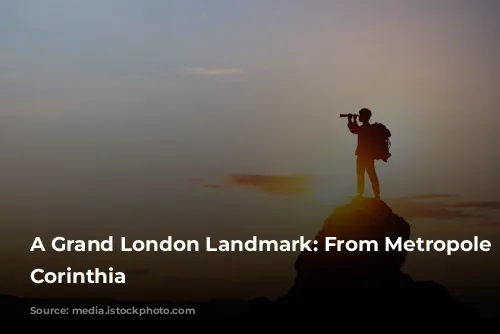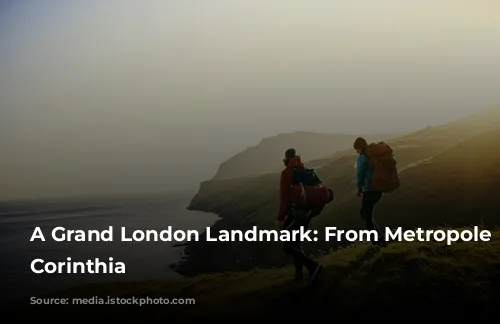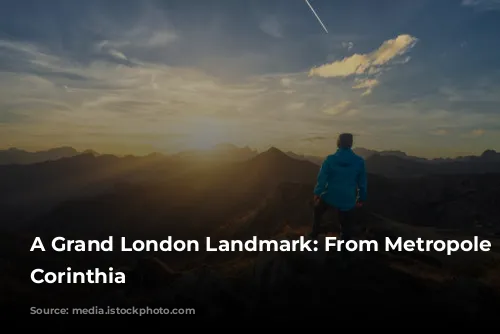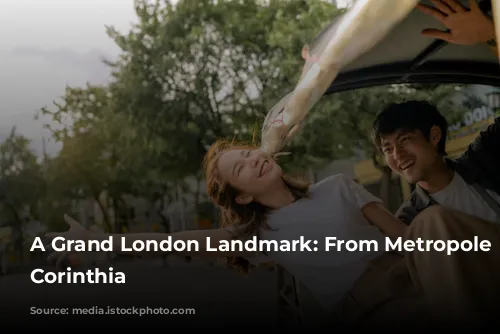Nestled in the heart of London, where bustling streets meet historic grandeur, stands a building with a rich past and a captivating present. The Corinthia Hotel London, a contemporary gem, occupies a triangular site nestled between the iconic Trafalgar Square and the Thames Embankment. This majestic structure, once known as the Metropole Hotel, has witnessed the ebb and flow of time, serving as a hub for royalty, government, and international intrigue.
The Metropole Hotel opened its doors in 1885, a grand structure designed to meet the demands of the era. Its proximity to the Palace of Westminster and Whitehall, home to government offices, made it a natural choice for dignitaries and influential figures. The hotel’s 88-page brochure, a testament to its opulence, boasted of luxurious accommodations and impeccable service.
Throughout its early years, the hotel was a vibrant social hub. The Aero Club and Alpine Club held their annual dinners within its walls, and the hotel served as the starting point for the first London to Brighton run in 1896. The Prince of Wales, later King Edward VII, was a frequent guest, enjoying a reserved box in the ballroom and the comfort of the Royal Suite, located on the first floor with a breathtaking view of Whitehall Place.
A Hotel Transformed: From World Wars to a New Era
With the outbreak of World War I, the hotel’s role shifted, transforming from a haven of luxury to a vital center for government operations. The Metropole, along with other buildings in the area, became a haven for government staff as the nation braced for conflict. On the eve of the British Expeditionary Force’s departure to France, the hotel housed the two Commanders-in-Chief, Field Marshals John French and Douglas Haig, a powerful symbol of the building’s wartime importance.
After the war, the Metropole Hotel reopened its doors as a hotel, embracing a new era of entertainment. The “Midnight Follies,” a captivating cabaret, became a popular fixture, attracting crowds seeking a dose of glamour and laughter. In 1921, a young musician named Bert Firman, only 16 years old, became the youngest bandleader in the world, leading the Midnight Follies Orchestra.
The Metropole’s connection to sporting history was etched in 1936, when the England Rugby Union team triumphed over the New Zealand All Blacks, a remarkable feat. This legendary victory, fueled by the awe-inspiring performance of Prince Alexander Obolensky, was immortalized in Pathé News footage, securing the Prince’s place in rugby folklore. The English team celebrated their victory at the Metropole, sharing the hotel with their victorious opponents.
A Government Hub: The Metropole’s Second Act
The Metropole’s fate took an unexpected turn in mid-1936 when the government leased the entire building, transforming it into a government hub. Initially, the Ministry of Labour and the Ministry of Transport occupied the space, followed by the Air Ministry and the Ministry of Defence. The government’s decision to secure the building reflected the growing need for efficient office space, a testament to the Metropole’s strategic importance during a time of heightened political activity.
As World War II loomed, the government again requisitioned the Metropole, further cementing its role as a center of wartime operations. The building housed various departments, including the crucial MI9 and its subdivision, the Special Operations Executive, tasked with covert operations behind enemy lines. The Metropole also served as a strategic planning hub, holding one of the model planning beaches for Operation Overlord, the Allied invasion of Normandy.

A Legacy of Transformation: From Government Building to Luxury Hotel
Following World War II, the Metropole Building was purchased by the government and incorporated into the Crown Estate portfolio. The Ministry of Defence continued to use it as a vital part of its Whitehall complex. By 1951, the Air Ministry had once again become a major occupant, followed by the Defence Intelligence Staff, who occupied the building from the mid-1960s until 1992.
In 2007, the Metropole building and its neighbor, 10 Whitehall Place, were acquired for a considerable sum by a consortium. After a meticulous restoration process, the building reopened its doors in 2011 as the Corinthia Hotel London, blending luxury accommodations with a unique blend of history and modern amenities.
The Corinthia Hotel, in its latest incarnation, continues to embrace its rich past. In 2011, it was the venue for the official announcement of the James Bond film Skyfall, solidifying its place in cinematic history. The hotel also served as a backdrop for scenes from the 2018 thriller Red Sparrow, and its press junket and photocall.

A Timeless Legacy: From Past to Present
The Corinthia Hotel stands today as a captivating reminder of London’s rich history, a testament to the city’s enduring allure. From its beginnings as a grand hotel to its role as a vital government hub, the building has witnessed the ebb and flow of time, always adapting to the needs of the era. As a hotel, it now offers a glimpse into the past while providing modern luxury and comfort, a fitting tribute to its enduring legacy.










